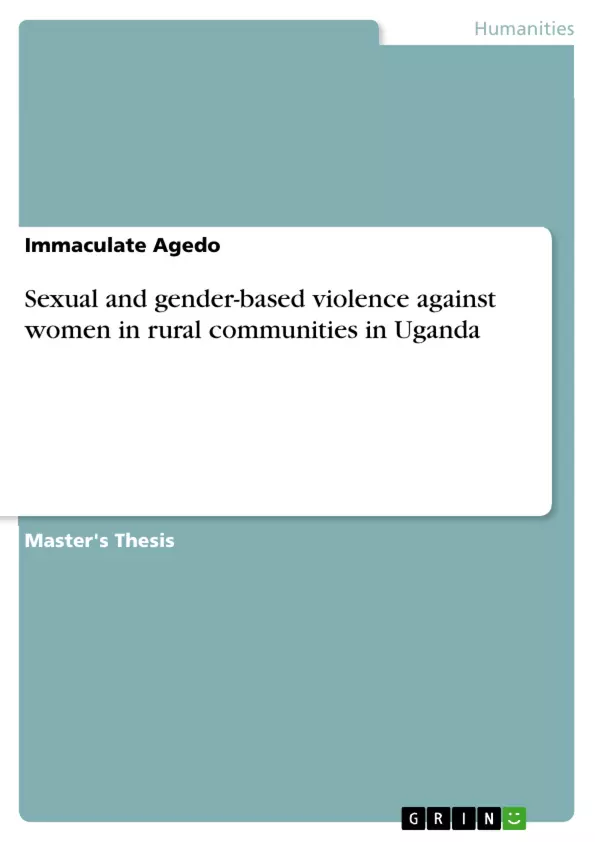The study established the effect of socio-cultural factors on the Management of Sexual and Gender Based Violence (SGBV) against women in Apac District, of Uganda. The specific objectives of the study were to assess the extent to which bride price practices affects Management of Sexual and Gender Based Violence against women in Apac District; to explain the effect of cultural norms on Management of Sexual and Gender Based Violence in Apac District; and to establish the extent to which the moderating effect of the composition of LC courts affect the management of sexual and gender based violence against women.
Literature on sociocultural and management of SGBV was reviewed. A case study research design was used supplemented by both qualitative and quantitative approaches. An accessible population of 320 elements was used to determine a sample size of 175 respondents. A 71% response rate was obtained. Key findings of the study include a positive significant relationship result for bride price practices (.355**), cultural norms (.580**) and composition of LC courts (.514**) on management of sexual and gender based violence.
The study concluded that SGBV acts led to splitting of more families. Fewer women reported domestic violence and women beaten were psychologically tormented and rarely were men apprehended when they beat their wives. However, many community members were not aware of violence in homes. Many women eloped as a result of domestic violence and many were isolated and neglected. Fewer LC courts adhered to a predefined mechanism, many women were dissatisfied with the court set up and injustice prevailed.
The study recommends that locally guidelines for payment of bride be formulated, use ceremonies such marriage and naming ceremonies to deliver SGBV information and informing communities that SGBV was punishable under the laws of Uganda. There is need to introduce a women’s desk for more work coordination, need to form a task force to review LC court composition and ensure a fair community evaluation exercise on the role played by the LC courts.
Inhaltsverzeichnis (Table of Contents)
- CHAPTER ONE.
- INTRODUCTION.
- 1.1 Introduction........
- 1.2 Background to the study.
- 1.2.1 Historical Background .......
- 1.2.2 Theoretical Background.
- 1.2.3 Conceptual Background……………………………….
- 1.2.4 Contextual Background.
- 1.4 Purpose of the Study..\li>
- 1.5 Specific objectives of the study..\li>
- 1.6 Questions........
- 1.7 Hypotheses of the study.
- 1.8 Conceptual framework..\li>
- 1.9 Significance of the Study.
- 1.10 Justification of the Study.
- 1.11 Scope of the Study
- 1.11.1 Content Scope..\li>
- 1.11.2 Geographical Scope.
- 1.11.3 Time Scope.
- 1.12 Operational definitions......
- CHAPTER TWO.
- LITERATURE REVIEW
- 2.1 Introduction….....
- 2.2 Theoretical review
- 2.3.1 Bride Price Practices and Management of Sexual and Gender Based Violence.
- 2.3.2 Cultural Norms and Management of Sexual and Gender Based Violence
- 2.3.3 Composition of Local Council Courts (LCC) and Management of Sexual and Gender Based Violence
- 2.4 Summary of the Literature..\li>
- CHAPTER THREE
- METHODOLOGY
- 3.1 Introduction......
- 3.2 Research design
- 3.3 Population of the study
- 3.4 Sample size and Sample selection
- 3.5 Sampling techniques and procedure.
- 3.6 Data Collection methods..\li>
- 3.6.1 Questionnaire survey
- 3.6.2 Interviews..\li>
- 3.6.4 Focus Group Discussion.
- The role of traditional norms and beliefs in perpetuating and mitigating sexual and gender-based violence.
- The effectiveness of local council courts (LCCs) in addressing sexual and gender-based violence.
- The impact of bride price practices on the management of sexual and gender-based violence.
- The challenges and opportunities for community-based interventions to prevent and respond to violence against women.
- The need for culturally sensitive and participatory approaches to addressing sexual and gender-based violence in rural settings.
Zielsetzung und Themenschwerpunkte (Objectives and Key Themes)
This dissertation aims to examine the socio-cultural factors that affect the management of sexual and gender-based violence against women in rural communities in Uganda. It focuses on the specific case of Apac district, aiming to shed light on the interplay between cultural norms, local governance structures, and the prevalence of such violence. The study seeks to understand how these factors impact the effectiveness of interventions and the overall response to violence against women in the community.
Zusammenfassung der Kapitel (Chapter Summaries)
Chapter 1: Introduction – This chapter sets the stage for the dissertation, providing a comprehensive overview of the study's background, objectives, research questions, and methodology. It explores the context of sexual and gender-based violence in Uganda, highlighting its prevalence and the challenges associated with addressing it effectively.
Chapter 2: Literature Review – This chapter delves into existing literature on sexual and gender-based violence, particularly within the context of developing countries. It examines theoretical frameworks, analyzes relevant research findings, and explores the specific challenges faced by women in rural communities. It specifically focuses on how traditional practices, cultural norms, and local governance structures contribute to the problem.
Chapter 3: Methodology – This chapter outlines the research methods employed in the study, providing a detailed explanation of the data collection techniques, sampling strategy, and data analysis procedures used. It outlines the specific research design adopted to gather information about the socio-cultural factors influencing the management of sexual and gender-based violence.
Schlüsselwörter (Keywords)
The research focuses on sexual and gender-based violence, socio-cultural factors, community management, rural Uganda, Apac district, traditional norms, bride price practices, local council courts, participatory interventions, and culturally sensitive approaches. These keywords encapsulate the primary themes and concepts explored in the dissertation, emphasizing the intersectionality of socio-cultural influences and the management of violence against women in the context of rural communities.
- Citar trabajo
- Immaculate Agedo (Autor), 2016, Sexual and gender-based violence against women in rural communities in Uganda, Múnich, GRIN Verlag, https://www.grin.com/document/425439



